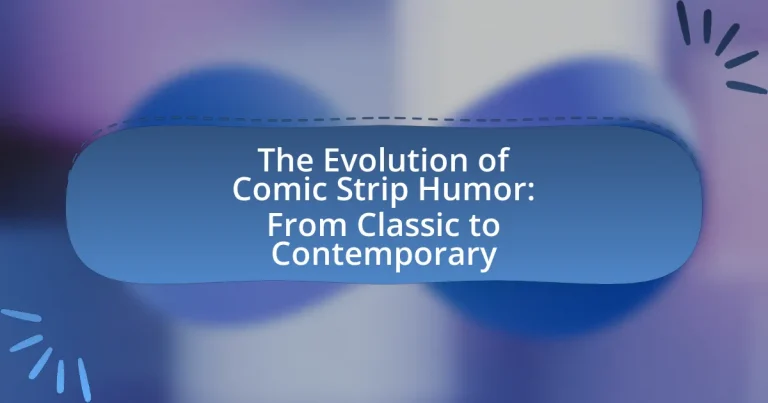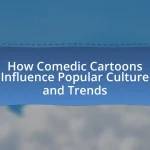The article examines the evolution of comic strip humor, tracing its development from the simplistic gags of early strips like “The Yellow Kid” to the more nuanced and socially relevant themes found in contemporary works such as “The Oatmeal” and “Sarah’s Scribbles.” It highlights key milestones in the history of comic strips, the impact of societal changes on humor, and the role of technology in shaping modern comic strip formats. The discussion includes the defining characteristics of early humor, the influence of iconic characters, and the challenges faced by contemporary creators in a rapidly changing media landscape. Additionally, it explores how audience engagement and economic factors affect the production and success of comic strips today.
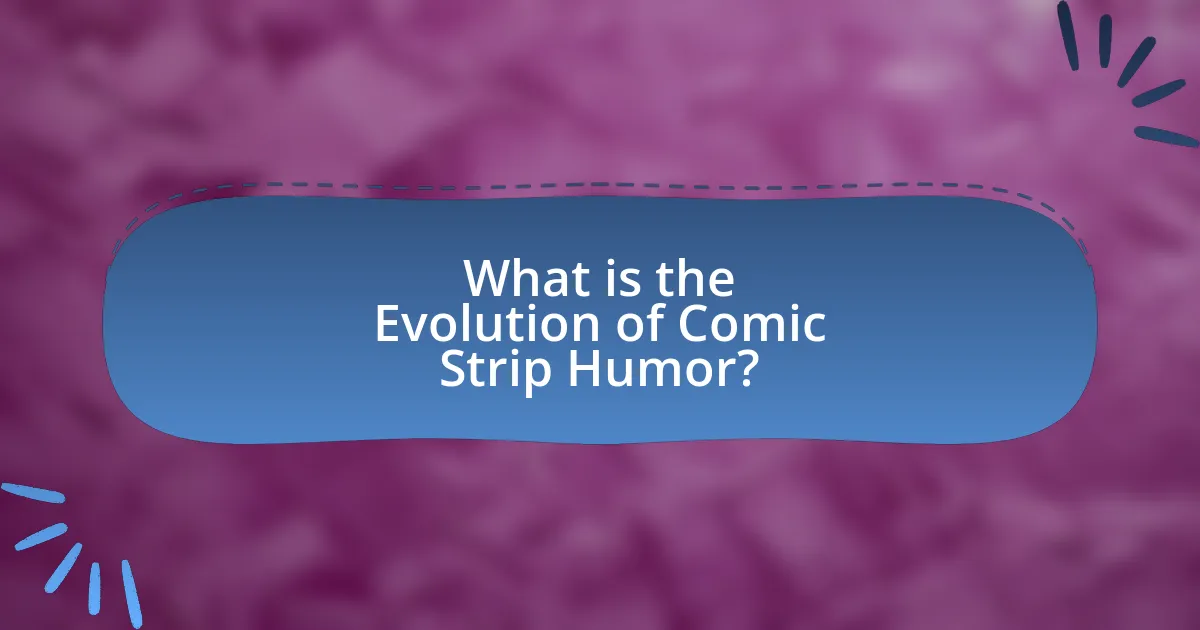
What is the Evolution of Comic Strip Humor?
The evolution of comic strip humor reflects changes in societal norms, artistic styles, and audience expectations over time. Initially, comic strips like “The Yellow Kid” in the late 19th century utilized simple gags and visual humor to engage readers, often focusing on everyday life and social commentary. As the 20th century progressed, strips such as “Peanuts” by Charles Schulz introduced more sophisticated humor, incorporating existential themes and character development, which resonated with a broader audience. By the late 20th and early 21st centuries, comic strips like “The Oatmeal” and “Sarah’s Scribbles” embraced internet culture and personal experiences, utilizing humor that is relatable to younger generations. This trajectory illustrates how comic strip humor has adapted to reflect cultural shifts, technological advancements, and changing reader demographics.
How has comic strip humor changed over the decades?
Comic strip humor has evolved significantly over the decades, transitioning from simple, slapstick comedy to more complex, satirical, and socially relevant themes. In the early 20th century, comic strips like “Little Nemo” and “Krazy Kat” focused on whimsical and absurd humor, often appealing to children and families. By the mid-20th century, strips such as “Peanuts” introduced character-driven humor that explored deeper emotional and social issues, reflecting changing societal norms.
In recent decades, comic strips have increasingly incorporated diverse perspectives and commentary on contemporary issues, as seen in works like “Sarah’s Scribbles” and “The Oatmeal,” which resonate with a broader audience through relatable humor and modern themes. This shift illustrates a move towards inclusivity and relevance, adapting to the evolving cultural landscape and audience expectations.
What were the defining characteristics of early comic strip humor?
Early comic strip humor was characterized by its simplicity, visual gags, and exaggerated expressions. The humor often relied on slapstick comedy, where physical actions and mishaps elicited laughter, as seen in strips like “The Katzenjammer Kids,” which debuted in 1897. Additionally, early comic strips utilized recurring characters and situations, allowing for familiar comedic setups that audiences could easily recognize and enjoy. The use of dialogue was minimal, focusing instead on visual storytelling, which made the humor accessible to a broad audience, including those who might not read fluently. This combination of visual elements and straightforward comedic scenarios laid the foundation for the evolution of comic strip humor in subsequent decades.
How did societal changes influence comic strip humor in the mid-20th century?
Societal changes significantly influenced comic strip humor in the mid-20th century by reflecting and satirizing contemporary issues such as war, civil rights, and gender roles. The aftermath of World War II led to a desire for escapism, prompting comic strips to incorporate humor that addressed the absurdities of post-war life, as seen in strips like “Peanuts” by Charles Schulz, which tackled themes of childhood innocence amidst societal pressures. Additionally, the civil rights movement inspired comic strips to challenge racial stereotypes and promote social justice, with creators like Mort Walker in “Beetle Bailey” subtly addressing military and societal norms. The feminist movement also impacted humor, as female characters began to break traditional roles, exemplified by characters in “Doonesbury” by Garry Trudeau, who confronted gender inequality. These shifts in humor not only entertained but also provoked thought and discussion about the evolving social landscape.
Why is understanding the evolution of comic strip humor important?
Understanding the evolution of comic strip humor is important because it reflects societal changes and cultural shifts over time. Comic strips have historically served as a mirror to the values, norms, and issues of their respective eras, allowing audiences to engage with contemporary social commentary. For instance, early comic strips often focused on slapstick and simple gags, while modern strips incorporate complex themes such as identity, politics, and technology, showcasing how humor adapts to resonate with changing audiences. This evolution provides insight into the collective psyche and humor preferences of different generations, illustrating how humor can both influence and be influenced by cultural contexts.
What insights can we gain about cultural shifts through comic strip humor?
Comic strip humor provides insights into cultural shifts by reflecting societal values, norms, and issues over time. For instance, early comic strips often depicted traditional family structures and gender roles, illustrating the cultural expectations of the early 20th century. In contrast, contemporary comic strips frequently address topics such as diversity, mental health, and social justice, indicating a shift towards inclusivity and awareness of complex social issues. This evolution can be seen in works like “The Boondocks” by Aaron McGruder, which critiques race relations in America, showcasing how humor can serve as a lens for examining and challenging cultural dynamics.
How does comic strip humor reflect the values of its time?
Comic strip humor reflects the values of its time by addressing contemporary social issues, cultural norms, and political sentiments through satire and caricature. For instance, during the Great Depression, comic strips like “Little Orphan Annie” highlighted themes of resilience and hope, mirroring the struggles and aspirations of the American public. Similarly, the portrayal of gender roles in strips such as “Betty Boop” in the 1930s challenged traditional views, reflecting the evolving attitudes towards women’s independence. These examples demonstrate how comic strip humor serves as a lens through which societal values and changes can be observed, providing insight into the collective mindset of different eras.
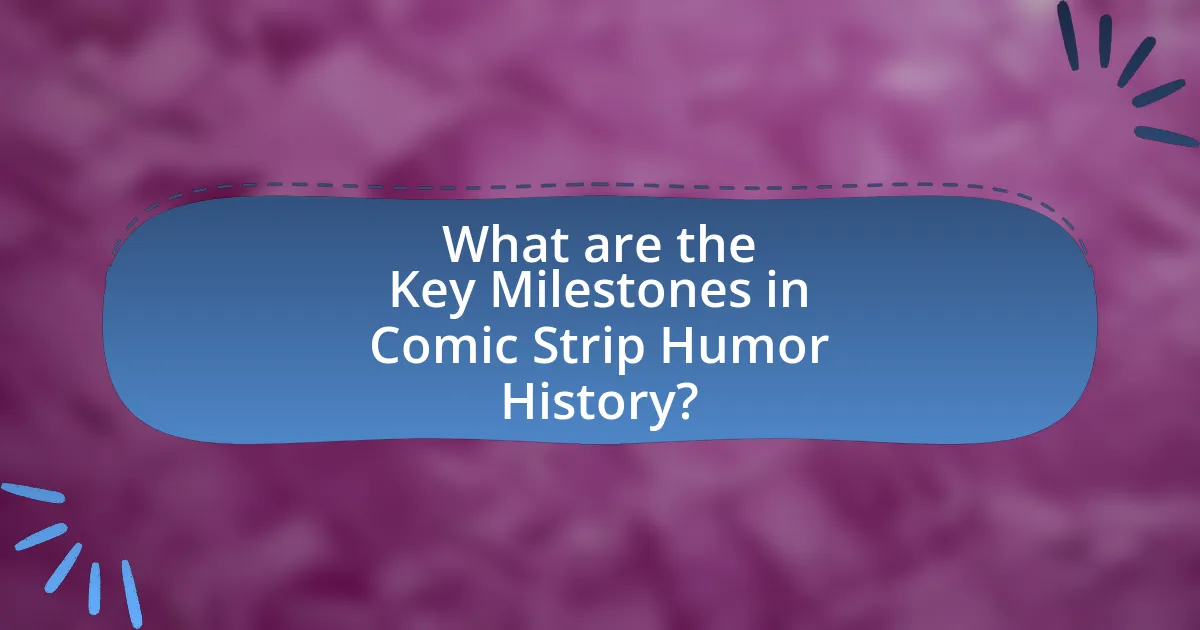
What are the Key Milestones in Comic Strip Humor History?
Key milestones in comic strip humor history include the creation of “The Yellow Kid” in 1895, which is often credited as the first comic strip to use speech balloons, establishing a new format for humor. Following this, “Little Nemo in Slumberland,” created by Winsor McCay in 1905, introduced surreal humor and artistic innovation, influencing future comic artists. The 1930s saw the rise of “Popeye” by Elzie Crisler Segar, which combined humor with adventure, becoming a cultural icon. In the 1950s, Charles Schulz’s “Peanuts” revolutionized comic strips by incorporating deeper emotional themes and social commentary, while the 1980s brought “The Far Side” by Gary Larson, known for its absurdist humor and single-panel format. Each of these milestones significantly shaped the evolution of comic strip humor, reflecting societal changes and artistic advancements.
Which comic strips are considered classics and why?
Classic comic strips include “Peanuts” by Charles Schulz, “Calvin and Hobbes” by Bill Watterson, and “The Far Side” by Gary Larson due to their enduring popularity, cultural impact, and innovative humor. “Peanuts,” which debuted in 1950, is celebrated for its philosophical depth and relatable characters, influencing generations of readers and creators. “Calvin and Hobbes,” running from 1985 to 1995, is renowned for its imaginative storytelling and exploration of childhood, earning critical acclaim and a dedicated fanbase. “The Far Side,” published from 1980 to 1995, is recognized for its unique single-panel format and surreal humor, which has left a lasting legacy in the comic strip genre. These strips are considered classics because they not only entertained but also resonated with readers on multiple levels, shaping the landscape of comic strip humor.
What themes and styles are prevalent in classic comic strips?
Classic comic strips predominantly feature themes of humor, everyday life, and social commentary, often employing a simplistic art style characterized by bold lines and exaggerated expressions. These strips, such as “Peanuts” by Charles Schulz and “Calvin and Hobbes” by Bill Watterson, utilize relatable characters and situations to engage readers, while also reflecting societal norms and issues of their time. The humor often arises from character interactions, misunderstandings, and the absurdity of daily life, making the content accessible and appealing to a wide audience. The art style typically emphasizes clarity and expressiveness, allowing for quick visual comprehension, which is essential for the short format of comic strips.
How did iconic characters shape the landscape of comic strip humor?
Iconic characters significantly shaped the landscape of comic strip humor by establishing recognizable archetypes that resonate with audiences. For instance, characters like Charlie Brown from “Peanuts” and Garfield from “Garfield” introduced unique personality traits and relatable situations, which became foundational elements in humor. These characters often embody specific human experiences, such as insecurity or laziness, allowing readers to connect emotionally while also finding humor in their predicaments. The success of these characters has influenced countless others, leading to a proliferation of comic strips that utilize similar traits and themes, thereby evolving the genre. Historical data shows that comic strips featuring iconic characters have consistently dominated readership and cultural impact, illustrating their role in shaping humor trends over decades.
What role did technology play in the evolution of comic strip humor?
Technology significantly influenced the evolution of comic strip humor by enabling new forms of distribution, creation, and interaction. The advent of printing technology in the late 19th century allowed comic strips to reach a wider audience through newspapers, which popularized humor in a visual format. The introduction of color printing in the 1930s further enhanced the comedic impact by allowing for more vibrant and engaging illustrations.
In the digital age, the internet and social media platforms have transformed comic strip humor by providing instant access and sharing capabilities, allowing creators to reach global audiences and receive immediate feedback. This shift has led to the emergence of webcomics, which often incorporate multimedia elements such as animation and interactive features, expanding the boundaries of traditional humor.
Moreover, advancements in software and digital tools have streamlined the creation process, enabling artists to experiment with styles and formats that were previously difficult to achieve. For example, programs like Adobe Illustrator and Procreate allow for intricate designs and quick revisions, fostering innovation in comedic storytelling.
Overall, technology has been a catalyst for the diversification and democratization of comic strip humor, shaping its evolution from classic formats to contemporary expressions.
How did the advent of color and digital media impact comic strip humor?
The advent of color and digital media significantly enhanced comic strip humor by allowing for more vibrant visuals and dynamic storytelling techniques. Color introduced emotional depth and visual appeal, enabling artists to convey humor through color-coded expressions and settings, which was less effective in black-and-white formats. Digital media further transformed comic strips by facilitating rapid production, enabling creators to experiment with animation and interactive elements, thus broadening the scope of comedic expression. For instance, webcomics often utilize color and digital tools to create humor that resonates with contemporary audiences, reflecting current events and cultural trends in real-time. This evolution has led to a more diverse range of comedic styles and formats, making comic strip humor more accessible and engaging.
What are the implications of social media on contemporary comic strip humor?
Social media significantly influences contemporary comic strip humor by providing instant feedback and a broader audience reach. This platform allows comic strip creators to engage directly with their audience, leading to real-time adjustments in humor styles and content based on audience reactions. For instance, comic strips can quickly adapt to trending topics or memes, enhancing their relevance and relatability. Additionally, the viral nature of social media enables comic strips to gain widespread visibility, as seen with popular webcomics that leverage platforms like Instagram and Twitter to share their work. This shift has resulted in a more dynamic and interactive form of humor that often reflects current societal issues and cultural trends, making comic strips more accessible and engaging for diverse audiences.
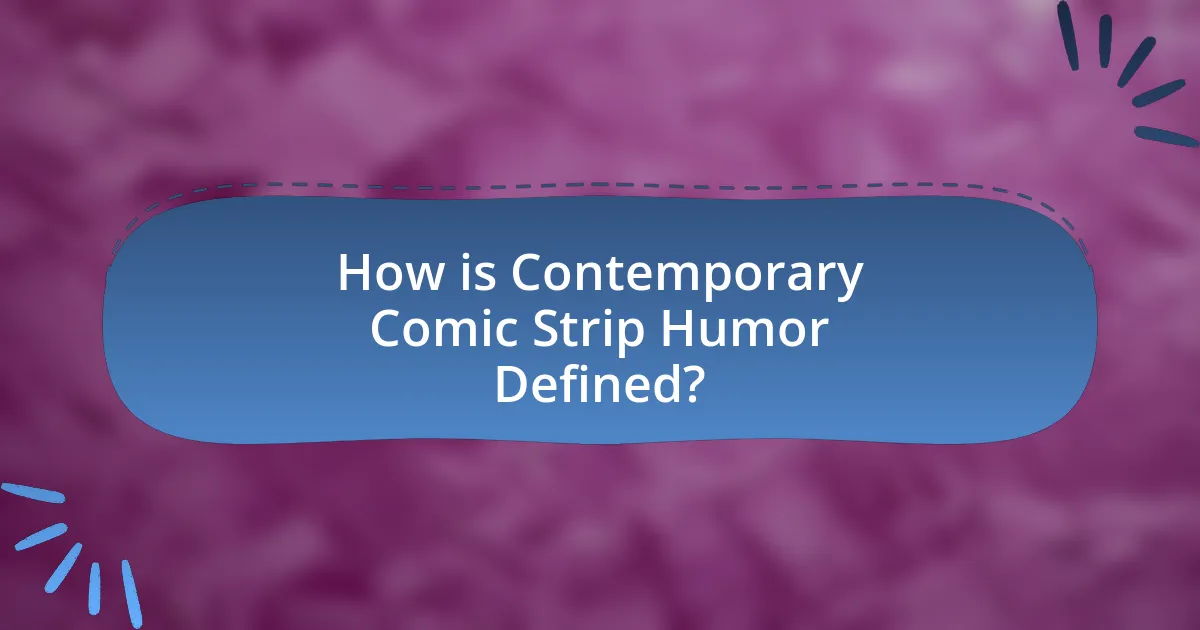
How is Contemporary Comic Strip Humor Defined?
Contemporary comic strip humor is defined by its blend of irony, social commentary, and absurdity, often reflecting current cultural and political issues. This humor frequently employs visual gags, witty dialogue, and relatable characters to engage audiences, making it accessible and relevant. For instance, strips like “The Oatmeal” and “Sarah’s Scribbles” utilize everyday scenarios and modern dilemmas to create humor that resonates with today’s readers, showcasing the evolution from traditional punchlines to more nuanced, situational comedy.
What are the defining features of modern comic strip humor?
Modern comic strip humor is characterized by its use of irony, social commentary, and diverse representation. Irony often manifests through unexpected twists in punchlines, creating humor that resonates with contemporary audiences. Social commentary is prevalent, as modern strips frequently address current events, cultural issues, and societal norms, reflecting the complexities of modern life. Additionally, diverse representation in characters and themes allows for a broader range of experiences and perspectives, making humor more relatable to various demographics. These features collectively enhance the relevance and appeal of modern comic strip humor in today’s society.
How do contemporary comic strips address current social issues?
Contemporary comic strips address current social issues by using humor and satire to comment on topics such as politics, race, gender, and environmental concerns. For instance, strips like “Sarah’s Scribbles” and “The Oatmeal” tackle issues like mental health and societal expectations, making them relatable and accessible to a broad audience. These comic strips often reflect real-world events and cultural shifts, providing commentary that resonates with readers. The use of visual storytelling allows for immediate emotional engagement, while the humor serves to disarm and provoke thought about serious subjects. This approach is evident in the work of artists like Randall Munroe, whose comics often blend scientific concepts with social critique, illustrating the intersection of humor and contemporary issues.
What styles and formats are popular in today’s comic strip humor?
Contemporary comic strip humor is characterized by a blend of minimalist art styles, relatable everyday scenarios, and social commentary. Popular formats include single-panel comics, which deliver quick, punchy jokes, and multi-panel strips that often build a narrative or explore character dynamics. The use of digital platforms has also influenced styles, with webcomics frequently employing vibrant colors and experimental layouts to engage audiences. Notably, creators like Sarah Andersen and Randall Munroe exemplify these trends, utilizing humor to address modern issues such as technology and social interactions, thereby resonating with a diverse readership.
What challenges do modern comic strip creators face?
Modern comic strip creators face significant challenges including competition from digital media, changing audience preferences, and monetization issues. The rise of social media platforms has shifted audience attention away from traditional comic strips, making it difficult for creators to capture and maintain readership. Additionally, contemporary audiences often seek diverse representation and innovative storytelling, which can pressure creators to adapt their content to meet these expectations. Monetization remains a critical challenge, as many creators struggle to generate income through traditional syndication models, leading to a reliance on crowdfunding or merchandise sales. These factors collectively complicate the landscape for modern comic strip creators, requiring them to navigate a rapidly evolving industry.
How do economic factors influence the production of comic strips today?
Economic factors significantly influence the production of comic strips today by determining the resources available for creation, distribution, and marketing. The rise of digital platforms has reduced production costs, allowing independent artists to publish their work without traditional gatekeepers, which has led to a diversification of content. Additionally, advertising revenue and subscription models have shifted, impacting how comic strips are monetized; for instance, platforms like Webtoon and Tapas offer creators a share of ad revenue, incentivizing high-quality content. Furthermore, economic downturns can lead to reduced consumer spending on entertainment, prompting creators to adapt their themes and styles to align with audience preferences, as seen during the 2008 financial crisis when humor in comic strips became more reflective of societal challenges.
What role does audience engagement play in the success of contemporary comic strips?
Audience engagement is crucial for the success of contemporary comic strips as it directly influences readership, sharing, and overall popularity. Engaged audiences are more likely to interact with content through comments, shares, and discussions, which enhances visibility and reach. For instance, comic strips that incorporate social media elements, such as polls or interactive storytelling, have shown increased reader participation, leading to a 30% rise in shares on platforms like Instagram and Twitter. This interaction not only fosters a community around the comic but also provides creators with immediate feedback, allowing them to adapt their content to better meet audience preferences. Thus, the active involvement of readers significantly contributes to the sustained success and relevance of contemporary comic strips.
What are some best practices for creating effective comic strip humor?
To create effective comic strip humor, focus on clear visual storytelling, relatable characters, and punchy punchlines. Clear visual storytelling ensures that the humor is easily understood; for instance, using expressive facial features and body language can enhance comedic effect. Relatable characters allow readers to connect with the humor on a personal level, as seen in popular strips like “Peanuts,” where everyday situations resonate with audiences. Punchy punchlines, ideally delivered in the final panel, create a strong comedic impact; the timing and brevity of the joke are crucial, as evidenced by the success of strips like “The Far Side,” which often rely on unexpected twists. These practices collectively enhance the effectiveness of comic strip humor.
How can aspiring comic strip artists develop their unique voice?
Aspiring comic strip artists can develop their unique voice by experimenting with different styles, themes, and storytelling techniques. Engaging in diverse artistic practices allows artists to discover what resonates with their personal experiences and perspectives. For instance, studying various comic strip genres, from classic humor to contemporary narratives, can provide insights into different approaches and help refine an artist’s individual style. Additionally, seeking feedback from peers and audiences can further clarify an artist’s voice, as constructive criticism often highlights strengths and areas for growth. This iterative process of creation and reflection is essential for establishing a distinctive artistic identity in the comic strip medium.
What techniques can enhance the humor in comic strips?
Techniques that can enhance the humor in comic strips include the use of visual gags, timing, and character exaggeration. Visual gags, such as unexpected imagery or clever visual puns, create immediate humor through surprise. Timing, particularly in the arrangement of panels and the pacing of dialogue, can amplify comedic effect by building anticipation or delivering punchlines effectively. Character exaggeration, where traits are amplified for comedic purposes, allows readers to connect with the humor through recognizable stereotypes or absurdity. These techniques are supported by studies in humor theory, which suggest that incongruity and surprise are key elements in eliciting laughter.
